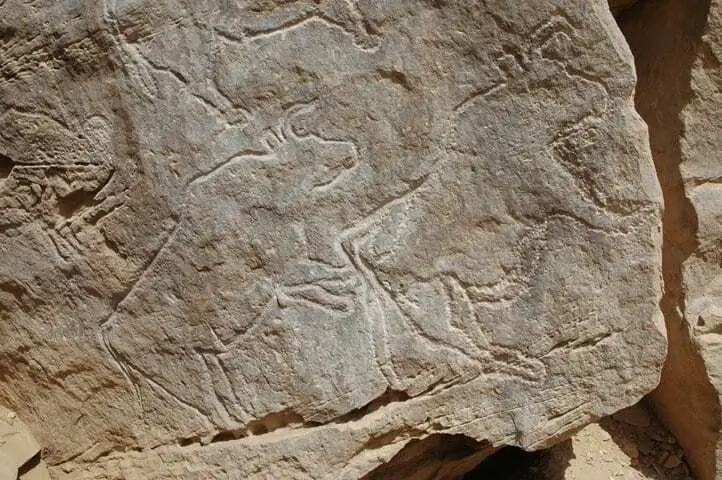The Qurta rock art – a series of carved images of birds, animals and some human figures – is at least 15,000 years old, according to an analysis of grains of sediment blown onto the rocks from the Nile river banks.
The carvings were discovered in 2005 on sandstone cliffs bordering the east side of the Egyptian Upper Nile Valley flood plain. The detective work then began of trying to determine the age of the carvings.
Using the technique of optically stimulated luminescence (OSL) dating, Dimitri Vandenberghe and colleagues at Ghent University in Belgium have pinpointed the date when sediment was blown onto the carvings.
The result means that the rock art is at least 15,000 years old, and probably older, because the carvings show signs of having already weathered before they became covered in sediment.
The study confirms the Qurta rock art to be the first known Pleistocene art in North Africa. Indeed, the carvings could be as old as 17,000 to 19,000 years, according to a report in December 2011 issue of the Quarterly Review of Archaeology, Antiquity (see “First evidence of Pleistocene rock art in North Africa: securing the age of the Qurta petroglyphs (Egypt) through OSL dating”. Antiquity vol 85, no 330, pages 1184-93).
Vandenberghe’s approach was to measure the ability of the sedimentary mineral grains to luminescence – or emit light. This property is both useful and challenging at the same time. It is useful because luminescence – which is due to the release of energy by minerals such as quartz builds up over time in the dark. The challenge, however, is that the luminescence clock is set to zero if a sample is exposed once again to sunlight. For archaeologists, this means that only samples of sediment that are still buried are suitable for analysis.
Fortunately, in 2008, geoarchaeologist Morgan De Dapper at Ghent University discovered that there were still some rock carvings at Qurta covered by sediment, and trapped beneath sandstone debris. He invited Vandenberghe to take samples for analysis by OSL, to determine when the sediment was deposited, thus recognising that this could yield a meaningful minimum age for the rock art.
“We were lucky that this coarse debris had ensured that the sediment remained in place for many thousands of years,” said Vandenberghe.
The lead archaeologist Dirk Huyge, Curator of Prehistoric and Early Dynastic Egypt Royal Museums of Art and History in Brussels, delayed excavation so that Vandenberghe could take samples from the deepest layer of sediment that was still in contact with the rock art.
He then analysed the sediment in a dark room to show that it was around 15,000 years ago that the particles were last exposed to sunlight and blown by the wind onto the rock.
“Most of what they encounter is sediment, and this is the only method that allows you to obtain an absolute age for sediment,” said Vandenberghe. He sees this type of study becoming increasingly important as archaeologists look to understand the geography around a site – such as when water may have been an important local feature, for example.
Ghent University
Written by Julie Clayton
Header Image Credit : Ghent University





